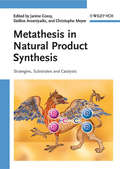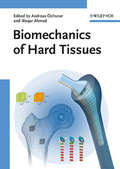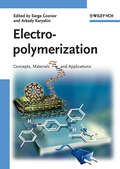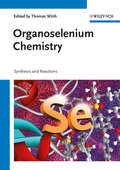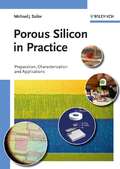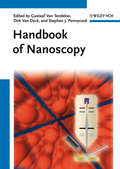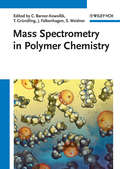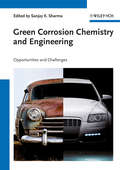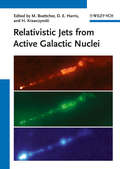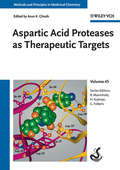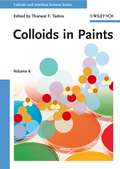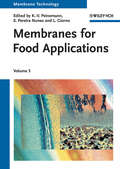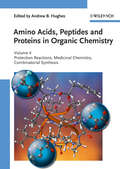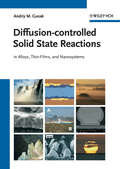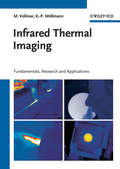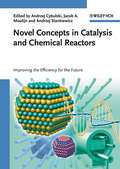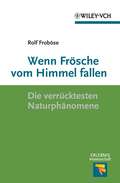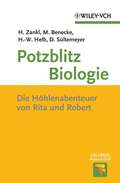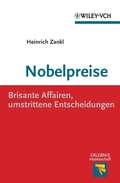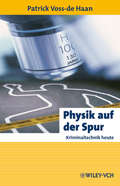- Table View
- List View
Metathesis in Natural Product Synthesis: Strategies, Substrates and Catalysts
by Stellios Arseniyadis Janine Cossy Christophe MeyerEmphasizing the impact of metathesis in natural product synthesis through the different types of key reactions, this is a comprehensive view of a hot topic. Written by top international authors, this ready reference is clearly structured and packed with important information, including representative experimental procedures for practical applications. A real must-have for anyone working in natural product synthesis.
Biomechanics of Hard Tissues: Modeling, Testing, and Materials
by Andreas Öchsner Waqar AhmedThis monograph assembles expert knowledge on the latest biomechanical modeling and testing of hard tissues, coupled with a concise introduction to the structural and physical properties of bone and cartilage. A strong focus lies on the current advances in understanding bone structure and function from a materials science perspective, providing practical knowledge on how to model, simulate and predict the mechanical behavior of bone. The book presents directly applicable methods for designing and testing the performance of artificial bones and joint replacements, while addressing innovative and safe approaches to stimulated bone regeneration essential for clinical researchers.
Electropolymerization: Concepts, Materials and Applications
by Serge Cosnier Arkady KaryakinProviding extensive coverage, including conducting, insulating and electroactive films, this handbook and ready reference deals with introductory topics and fundamentals as well as advanced insights. Clearly structured, in the first part of the book readers learn the fundamentals of electropolymerizatoin for all important types of polymers, mechanisms of film formation and functionalization, while the second part covers a wide range of applications in biochemistry, analytics, photovoltaics, energy and the environment as well as actuators.
Organoselenium Chemistry
by Thomas WirthSelenium-based methods in synthetic chemistry have developed rapidly over the past years and are now offering highly useful tools for organic synthesis. Filling the gap for a comprehensive handbook and ready reference, this book covers all modern developments withinthe field, including biochemical aspects. The chemistry chapters are organized according to the different reactivities of various seleniumcompounds and reagents, with each chapter dealing with a special reaction type. Also includes a table with 77Se NMR shifts to aid in practical problems.From the Contents:* Electrophilic and Nucleophilic Selenium* Selenium Compounds in Radical Reactions* Selenium-Stabilized Carbanions* Selenium Compounds with Valency Higher than Two* Selenocarbonyls* Selenoxide Elimination and [2,3]-Sigmatropic Rearrangement* Selenium Compounds as Ligands and Catalysts* Biological and Biochemical Aspects of Selenium Compounds
Porous Silicon in Practice
by M. J. SailorBy means of electrochemical treatment, crystalline silicon can be permeated with tiny, nanostructured pores that entirely change the characteristics and properties of the material. One prominent example of this can be seen in the interaction of porous silicon with living cells,which can be totally unwilling to settle on smooth silicon surfaces but readily adhere to porous silicon, giving rise to great hopes for suchfuture applications as programmable drug delivery or advanced, braincontrolled prosthetics. Porous silicon research is active in the fieldsof sensors, tissue engineering, medical therapeutics and diagnostics, photovoltaics, rechargeable batteries, energetic materials, photonics,and MEMS (Micro Electro Mechanical Systems). Written by an outstanding, well-recognized expert in the field, this book provides detailed, step-by-step instructions to prepare and characterize the major types of porous silicon. It is intended for those new to the fi eld. Sampling of topics covered: * Principles of Etching Porous Silicon* Etch Cell Construction and Considerations* Photonic Crystals, Microcavities, and Bragg Stacks Etched in Silicon* Preparation of Free-standing Films and Particles of Porous Silicon* Preparation of Photoluminescent Nanoparticles from Porous Silicon* Preparation of Silicon Nanowires by Electrochemical Etch of Silicon* Surface Modifi cation Chemistry and Biochemistry* Measurement of Optical Properties* Measurement of Pore Size, Porosity, Thickness, Surface AreaThe whole is backed by a generous use of color photographs to illustrate the described procedures in detail, plus a bibliography of furtherliterature pertinent to a wide range of application fi elds. For materials scientists, chemists, physicists, optical physicists, biomaterialsscientists, neurobiologists, bioengineers, and graduate students in those fields, as well as those working in the semiconductor industry.
Handbook of Nanoscopy, 2 Volume Set
by Stephen J. Pennycook Dirk Van Dyck Gustaaf Van TendelooThis completely revised successor to the Handbook of Microscopy supplies in-depth coverage of all imaging technologies from the optical to the electron and scanning techniques. Adopting a twofold approach, the book firstly presents the various technologies as such, before going on to cover the materials class by class, analyzing how the different imaging methods can be successfully applied. It covers the latest developments in techniques, such as in-situ TEM, 3D imaging in TEM and SEM, as well as a broad range of material types, including metals, alloys, ceramics, polymers, semiconductors, minerals, quasicrystals, amorphous solids, among others. The volumes are divided between methods and applications, making this both a reliable reference and handbook for chemists, physicists, biologists, materials scientists and engineers, as well as graduate students and their lecturers.
Mass Spectrometry in Polymer Chemistry
by Steffen Weidner Jana Falkenhagen Christopher Barner-Kowollik Till GruendlingCombining an up-to-date insight into mass-spectrometric polymer analysis beyond MALDI with application details of the instrumentation, this is a balanced and thorough presentation of the most important and widely used mass-spectrometric methods.Written by the world's most proficient experts in the field, the book focuses on the latest developments, covering such technologies and applications as ionization protocols, tandem and liquid chromatography mass spectrometry, gas-phase ion-separation techniques and automated data processing. Chapters on sample preparation, polymer degradation and the usage of mass-spectrometric tools on an industrial scale round off the book.As a result, both entrants to the field and experienced researchers are able to choose the appropriate methods and instrumentations -- and to assess their respective strengths and limitations -- for the characterization of polymer compounds.
Green Corrosion Chemistry and Engineering: Opportunities and Challenges
by Sanjay K. SharmaWith its unique focus on specifically addressing the problems for societies and economies associated with corrosion and their solution, this book provides an up-to-date overview of the progress in corrosion chemistry and engineering. International experts actively involved in research and development place particular emphasis on how to counter the economic and environmental consequences of corrosion with the help of science and technology, making this a valuable resource for researchers as well as decision makers in industry and politics. Further major parts of the book are devoted to corrosion prevention in the naval and energy sector as well as to corrosion monitoring and waste management.
Relativistic Jets from Active Galactic Nuclei
by Henric Krawczynski Daniel E. Harris Markus BoettcherWritten by a carefully selected consortium of researchers working in the field, this book fills the gap for an up-to-date summary of the observational and theoretical status. <P><P>As such, this monograph includes all used wavelengths, from radio to gamma, the FERMI telescope, a history and theory refresher, and jets from gamma ray bursts. For astronomers, nuclear physicists, and plasmaphysicists.
Aspartic Acid Proteases as Therapeutic Targets (Methods and Principles in Medicinal Chemistry #45)
by Raimund Mannhold Gerd Folkers Hugo KubinyiIn this ground-breaking practical reference, the family of aspartic acid proteases is described from a drug developer's perspective. The first part provides a general introduction to the family of aspartic acid proteases, their physiological functions, molecular structure and inhibition. Parts two to five present various case studies of successful protease inhibitor drug design and development, as well as current and potential uses of such inhibitors in pharmaceutical medicine, covering the major therapeutic targets HIV-1 protease, renin, beta-secretase, gamma-secretase,plasmepsins and fungal proteases. A ready reference aimed primarily at professionals in the pharmaceutical industry, as well as for anyone studying proteases and their function.
Colloids in Paints (Colloids and Interface Science (VCH) #6)
by Tharwat F. TadrosThe first modern approach to relate fundamental research to the applied science of colloids, this series bridges academic research and practical applications, thus providing the information vital to both. Written by the very best scientists in their respective disciplines, this volume describes the role of colloids in paints, highlighting the importance of fundamental research in industrial applications. For surface, polymer and physicochemists, materials scientists, and chemical engineers.
Membrane Technology, Volume 3: Membranes for Food Applications, 1st Edition
by Klaus-Viktor Peinemann Lidietta Giorno Suzana Pereira NunesEdited by an internationally recognized leader in the field, this third volume in the series represents the complete reference to membrane processes in the food industry. The handbook adopts a highly practical approach to this hot topic, combining the hands-on experience of the expert authors involved. They provide chapters devoted to such varied applications as dairy fractionation, electrodialysis, pressure-driven membrane processes in alcoholic beverages, membrane emulsification, contactors and bioreactors, as well as membranes for food packaging.
Amino Acids, Peptides and Proteins in Organic Chemistry, Protection Reactions, Medicinal Chemistry, Combinatorial Synthesis (Amino Acids, Peptides and Proteins in Organic Chemistry (VCH) #6)
by Andrew B. HughesThis is the fourth of five books in the Amino Acids, Peptides and Proteins in Organic Synthesis series. Closing a gap in the literature, this is the only series to cover this important topic in organic and biochemistry. Drawing upon the combined expertise of the international "who's who" in amino acid research, these volumes represent a real benchmark for amino acid chemistry, providing a comprehensive discussion of the occurrence, uses and applications of amino acids and, by extension, their polymeric forms, peptides and proteins. The practical value of each volume is heightened by the inclusion of experimental procedures. The 5 volumes cover the following topics: Volume 1: Origins and Synthesis of Amino Acids Volume 2: Modified Amino Acids, Organocatalysis and Enzymes Volume 3: Building Blocks, Catalysis and Coupling Chemistry Volume 4: Protection Reactions, Medicinal Chemistry, Combinatorial Synthesis Volume 5: Analysis and Function of Amino Acids and Peptides The fourth volume in this series is structured in three main sections. The first section is about protection reactions and amino acid based peptidomimetics. The second, and most extensive, part is devoted to the medicinal chemistry of amino acids. It includes, among others, the chemistry of alpha- and beta amino acids, peptide drugs, and advances in N- and O-glycopeptide synthesis. The final part deals with amino acids in combinatorial synthesis. Methods, such as phage display, library peptide synthesis, and computational design are described. Originally planned as a six volume series, Amino Acids, Peptides and Proteins in Organic Chemistry now completes with five volumes but remains comprehensive in both scope and coverage. Further information about the 5 Volume Set and purchasing details can be viewed here.
Diffusion-controlled Solid State Reactions: In Alloys, Thin Films and Nanosystems
by Andriy M. Gusak A. S. Shirinyan T. V. Zaporozhets Yu. O. Lyashenko M. O. Pasichnyy S. V. KornienkoWritten by an outstanding group of applied theoreticians with comprehensive expertise and a wide spectrum of international contacts headed by Prof. A. M. Gusak, this monograph coherently presents the approaches and results hitherto only available in various journal papers. A must-have for all those involved with the public or corporate science of nano systems, thin films and electrical engineering.
Infrared Thermal Imaging: Fundamentals, Research and Applications
by Michael Vollmer Klaus-Peter MöllmannThis richly illustrated hands-on guide is designed for researchers, teachers and practitioners. The huge selection of examples taken from science, basic teaching of physics, practical applications in industry and a variety of other disciplines spanning the range from medicine to volcano research allows readers to pick those that come closest to their own individual task at hand. Following a look at the fundamentals of IR thermal imaging, properties of the imaging systems, as well as basic and advanced methods, the book goes on to discuss IR imaging applications in teaching, research and industry. Specific examples include thermography of buildings, microsystems and the rather new field of IR imaging of gases. Impartially written by expert authors in the field from a renowned applied science institution, who are in the unique position of having both experience in public and private research and in teaching, this comprehensive book can be used for teaching beginners in the field as well as providing further education to specialized staff, students and researchers.
Infrared Thermal Imaging: Fundamentals, Research and Applications
by Michael Vollmer Klaus-Peter MöllmannThis richly illustrated hands-on guide is designed for researchers, teachers and practitioners. The huge selection of examples taken from science, basic teaching of physics, practical applications in industry and a variety of other disciplines spanning the range from medicine to volcano research allows readers to pick those that come closest to their own individual task at hand. Following a look at the fundamentals of IR thermal imaging, properties of the imaging systems, as well as basic and advanced methods, the book goes on to discuss IR imaging applications in teaching, research and industry. Specific examples include thermography of buildings, microsystems and the rather new field of IR imaging of gases. Impartially written by expert authors in the field from a renowned applied science institution, who are in the unique position of having both experience in public and private research and in teaching, this comprehensive book can be used for teaching beginners in the field as well as providing further education to specialized staff, students and researchers.
Novel Concepts in Catalysis and Chemical Reactors: Improving the Efficiency for the Future
by Andrzej Cybulski et al.The chemical process industry faces a tremendous challenge of supplying a growing and ever more demanding global population with the products we need. The average efficiency at which resources are converted into the final products is however still dramatically low. The most obvious solution is to carry out chemical conversions at much higher yields and selectivity and this is where active and selective catalysts and efficient chemical reactors play a crucial role. Written by an international team of highly experienced editors and authors from academia and industry, this ready reference focuses on how to enhance the efficiency of catalysts and reactors. It treats key topics such as molecular modeling, zeolites, MOFs, catalysis at room temperature, biocatalysis, catalysis for sustainability, structured reactors including membrane and microchannel reactors, switching from batch to continuous reactors, application of alternative energies and process intensification. By including recent achievements and trends, the book provides an up-to-date insight into the most important developments in the field of industrial catalysis and chemical reactor engineering. In addition, several ways of improving efficiency, selectivity, activity and improved methods for scale-up, modeling and design are presented in a compact manner.
Wenn Frösche vom Himmel fallen: Die verrücktesten Naturphänomene (Erlebnis Wissenschaft)
by Rolf FroböseAs incredible as it may sound, nature is still unbeatable and provides us with the most amazing inventions and phenomena, beyond human imagination. Bacteria that produce plastic or electricity, for example, or natural rocket propulsion or algae that may meet the energy needs of future generations with their supplies of hydrogen. How is it that frogs and fish fall from the sky, how does the dust from the Sahara reach the Caribbean and what lies behind the mysteries of the deep-sea methane oases? Yet nature has also invented modern technologies. A natural solar power plant, for example, provides an Antarctic lake with an agreeable water temperature, and the first functioning nuclear reactor existed in Africa two billion years ago. Nature even created the very first laser. Researchers around the globe are increasingly searching for ways of using nature's inventions for developing new products and concepts. One case in point are extremophile bacteria, which thrive at the baking temperature of 140 degrees Celsius. The resulting enzymes should prove fruitful in chemistry. But also chemosensors, which work like a dog's nose, and bulletproof jackets based on spiders' webs are visions that could profit from evolution's treasure trove.
Potzblitz Biologie: Die Höhlenabenteuer von Rita und Robert (Erlebnis Wissenschaft)
by Heinrich Zankl Mark Benecke Hans-Wolfgang Helb Dieter SültemeyerBrother and sister Robert and Rita are just as curious as other children. That is why they have to explore the snake cave, the entrance to which they have rediscovered by chance. After school they sneak off to have many an adventure inside the cave. Not only do thy come across such animals as spiders, foxes, toads and owls, but also a treasure trove and strange graffiti on the walls. This is when they both turn into detectives: Who used to live in the cave? And even the police have to be called when a skeleton is discovered. Gripping entertainment for young readers from 10 onwards. Alongside the well told horror story, topics on nature and history are covered in their own boxes and accompanied by many line drawings. Complete with cross references and recommended further reading.
Nobelpreise: Brisante Affairen, umstrittene Entscheidungen (Erlebnis Wissenschaft)
by Heinrich ZanklDer Nobelpreis ist die wichtigste Ehrung weltweit. Dass bei der Auswahl und Vergabe vielleicht nicht immer alles mit richtigen Dingen zugeht, ist nur menschlich - und dazu kann man viele interessante, witzige und prekäre Geschichten erzählen.
Irrwitziges aus der Wissenschaft: Von Dunkelbirnen und Leuchtkaninchen (Erlebnis Wissenschaft)
by Heinrich ZanklScience need not only be amusing, it can even be side-splittingly funny. This book presents oddities from various areas of knowledge: weird events, involuntary funnies or "facts" that have become twisted over the years. These include "The phenomenon of the disappearing tea spoons", "Sir Herschel's supposed lunar studies" and "The Mittelstress method", as well as Schiller and Goethe's hashish consumption. The stories and anecdotes can be read in one go or section-by-section, or dipped into every now and then, and are intended to make the reader, whether a scientist or layperson, laugh. After all, life is serious enough as it is.
Fälscher, Schwindler, Scharlatane: Betrug in Forschung und Wissenschaft (Erlebnis Wissenschaft)
by Heinrich ZanklJetzt als Sonderausgabe! Kennen Sie den Mogelfaktor? Gibt es diesen etwa auch in der hehren Forschung? Ja, und er perfektionierte beispielsweise die Ergebnisse vom ehrenwehrten Sir Isaac Newton. Er kreierte auch Laborbuchnotizen für den Kardiologen Darsee und transferierte auf magische Weise Bakterienstämme von einem Universitätslabor in das Labor der Firma Genentech. Selbst fiktive Mitarbeiterinnen erschuf der Mogelfaktor, die für den Zwillingsforscher Cyril Burt ebenso fiktive Zwillingsstudien durchführten; und diese beeinflussten noch jahrelang die Intelligenzforschung auf der ganzen Welt! Heinrich Zankl hat alte und neue Skandale in den Geistes- und Naturwissenschaften überzeugend recherchiert und zu einem Geflecht aus wertvoller Information und guter Unterhaltung verwoben. Dieses Buch erzählt viele Geschichten, beispielsweise die eines Nobelpreises, der an die Falschen verliehen wurde, von der Unterdrückung von Kritikern und sogar von einem Wissenschaftsbetrüger, der vom Bundesverfassungsgericht geschützt wird. Manche Aspekte sind dabei so grotest, dass sich kein Leser das Schmunzeln verkneifen kann. Ein Lesevergnügen, nicht nur für Wissenschaftler.
Maschinen mit Bewusstsein: Wohin Führt die Künstliche Intelligenz? (Erlebnis Wissenschaft)
by Bernd VowinkelMochten Sie mit einem Roboter Handchen halten? Wie fuhlt sich das wohl an? Sind Bewusstsein und Emotionen konstruierbar - oder bleiben sie ein allein menschliches Privileg? Schon im Jahr 2015 sind PCs ahnlich leistungsfahig wie das menschliche Gehirn. Das klingt zwar wie Science-Fiction, ist jedoch die gut begrundete Prognose von Wissenschaftlern, die sich mit Kunstlicher Intelligenz beschaftigen. Dabei geht es dem Autor, Bernd Vowinkel, nicht nur ausschlie?lich um die blo?e technische Machbarkeit: er stellt sowohl Gedankenexperimente vor, die in die Grenzbereiche von Philosophie und Wissenschaft vorsto?en, aber er geht auch existenziellen Fragen nach den langfristigen Auswirkungen der KI auf unsere Zivilisation nicht aus dem Weg. Dank seiner allgemein verstandlichen Sprache ist das Buch fur Jeden, der an kunstlicher Intelligenz interessiert ist, eine spannende Wanderung auf dem Grat zwischen Realitat und Fiktion!
Physik auf der Spur: Kriminaltechnik heute (Erlebnis Wissenschaft)
by Patrick Voss-de HaanPatrick Voss-de Haan, Mitarbeiter des BKA und seit vielen Jahren mit naturwissenschaftlichen Anwendungen in der Kriminaltechnik befasst, legt mit diesem Werk eine spannend geschriebene und auch für Laien verständliche Einführung in Techniken, Verfahren sowie aktuelle und zukünftige Aufgaben der Kriminalitätsprävention und -bekämpfung vor. Im Zusammenspiel der verschiedensten Disziplinen - Physik, Chemie, Werkstofftechnik oder auch Psychologie - ist die Kriminaltechnik immer dann gefragt, wenn es um solide Beweisketten geht. Wichtigstes Hilfsmittel ist das Rasterelektronen-Mikroskop (REM): War der Verdächtige am Tatort? - Aufschluss kann eine Untersuchung geben, ob sich zum Beispiel Faserspuren vom Opfer an seiner Kleidung finden oder umgekehrt. War der Blinker zum Zeitpunkt des Unfalls eingeschaltet? - Hier hilft eine Betrachtung der Glühwendel. Wurde das gefundene Projektil aus dem Lauf der sichergestellten Waffe abgefeuert? - Eine vergleichende Untersuchung mit einem Projektil aus einem "Probeschuss" beantwortet diese Frage. Voss-de Haan geht in seinem Buch auf diese und zahlreiche andere Fälle ein, bei deren Aufklärung die Naturwissenschaften eine wichtige Rolle spielen. So können entfernte und überschriebene Fahrgestellnummern gestohlener Autos durch Verfahren wie Ätzen oder die so genannte Kavitationserosion wieder sichtbar gemacht werden. Und anhand der Zusammensetzung des Tonermaterials und charakteristischer Spuren auf dem Vorlagenglas lassen sich Fotokopierer "identifizieren", auf denen Erpresserschreiben vervielfältigt wurden. Das Buch zeigt, was Kriminaltechnik heute zu leisten imstande ist. Wer gerne knifflige Fälle löst, wird überrascht sein, welche Rolle die Physik dabei spielt.
Mehr als Sonne, Wind und Wasser: Energie für eine neue Ära (Erlebnis Wissenschaft)
by Christian SynwoldtWhat are the energy sources of the future and what technologies can we rely on? These are the questions that show the precarious situation our planet is in. Which is why we need solid answers - for laypeople and the scientifically-minded as well as for politicians and students of the relevant disciplines. The author provides here a compact and comprehensible overview of our future energy resources. Alongside a detailed and richly illustrated introduction to the various technologies, he also discusses the fundamental problem of energy storage. The author is an electrical engineer working as a consultant for a group of inventors in regenerative energies, and reports on the latest research approaches.
